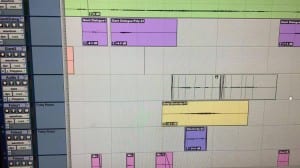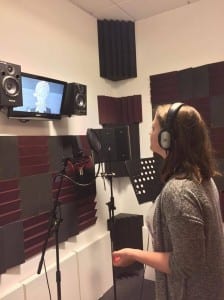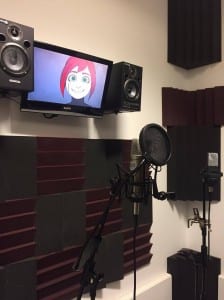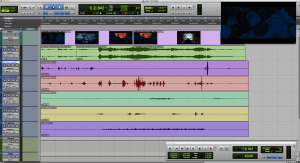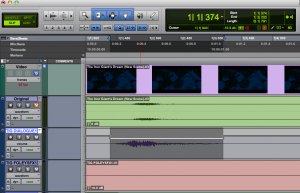Overview
This project was carried out with course colleague Ben Hollick. It has taught me a lot regarding the practical and theoretical side of sound design, freelance working and time management. Whilst collaborating with Ben, we made our aim to create a business-like website for our post-production freelance work to be showcased. I believe the redesign and bespoke soundtrack works have been completed to a professional and satisfactory standard. In this project, we both completed a redesign soundtrack each and together created a bespoke soundtrack for a short animated film. My research aspect of the project was to investigate the practices of sound design work and also explore the application of theoretical works from academics in the field of sound design.
Project Strengths
There are many strengths to this project, one being the understanding I have gained from learning how to carry out elements of sound design and incorporate them in my work. The research aspect of going away and figuring out how to record or edit sounds to your requirements has been a successful aspect of research in Audio Project 2. I have also research theoretical uses of sound in film and applied them to my work. This different aspect of research gave my soundtracks more meaning, rather than just creating an artefact that ‘sounds good’. I have also discovered more about being a freelance creative, and now have a better understanding of how to obtain work and operate as a business if I were to freelance in the industry.
I am happy with the outcome of both my redesign and the animation soundtrack. They both entail different sounds incorporated from researching various uses of sound. The fight scene involved a lot of sound that may not have actually been heard in terms of diegetic sound. These sounds have been exaggerated for the purpose of cliché animation sound design and to intensify the scene. I believe I have achieved each one of my learning outcomes. Our client, Charlotte is also happy with the outcome of the soundtrack. This is the best way to measure the success of our bespoke soundtrack, as ultimately that is who it is tailored to.
The project has improved my abilities in areas such as recording. The extensive use of the sound theatre enabled this. I have also learnt how to perform an array of sound editing techniques I did not know of prior to the project. Ben and myself did not clash in terms of opinion on many things regarding the project at all, which is rare considering there was a lot of elements that can be slightly altered to personal opinion
Project Weaknesses
Initially, our methodology in our approach to the project was too time consuming and we were not recording and editing as quickly as we would have liked. After a tutorial with Lee we started to use tick sheets, which helped us organise our workflow more efficiently. This is a technique I would use if I were to do the project again. Another weakness came in the file sessions we were receiving from our Animation client, Charlotte. She was using different software and editing various scenes, when she sent us the updated version of the animatic it would put all of our recordings out of time. There seemed to be no way out of this, as unlike in the industry, we were working on different sessions. We could only work to the updated version we had.
If our methodology was correct from the start, we could have spent more time on perfecting sounds within our redesign work and our animation soundtrack. Despite there being many things affecting the workflow of our project along the way, we did manage to fix up our organisational skills. Overall, I am happy with the outcome of both soundtracks, as they have derived from significant research and time spent on it.
Project Opportunities
This project has created opportunities in regards to obtaining freelance work in the industry. After setting up our ‘business’ and website our works can now be showcased online. Ben’s side of the research was to create this website design. The project has also prepared me for going into a job in post-production. The research aspect of this project enabled me to investigate how certain sounds and Foley are created. The project also gave me time to experiment with my work, as seen in my blog I tried various recording techniques such as the use of contact microphones and hydrophones. The project also prepared me for the ‘paperwork’ side of freelance work, and has provided me with a more realistic view of how to operate as a freelance creative.
The project allowed me to research many aspects of foley. Such as; creating a punch sound effect, experimenting with lasers through using metal and a slinky and recording sounds underwater.
Project Threats
The project did not see too many threats apart from a couple of deadline issues. Originally, Ben and myself had to get an extension because I had injured my dominant hand and could not use it. However, the Animation course also had extensions exceeding ours anyway. This allowed us to regain lost time. However, when our deadline came around the animation was not fully finished. This acts as a potential threat to our work as although the soundtrack is complete, the picture is not and it is a shame the picture could not be completed for our hand-in.
Summary
Overall, the project was interesting and informative. I have learnt how to create professional soundtracks, from researching both of the theoretical and practical approaches to sound design. I have also had experience in working with a client, who made us change several sound to her stylistic requirements. This gave me an insight to working in the industry, as I’m sure there is a lot more awkward client than charlotte out there. Applying relevant lectures to my works has also informed me on the practical processes of sound design, and how to operate as a freelancer.


